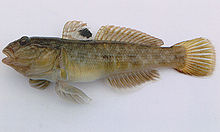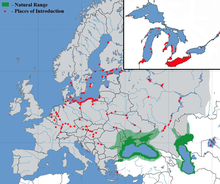| Round goby | |
|---|---|

| |
| Scientific classification | |
| Domain: | Eukaryota |
| Kingdom: | Animalia |
| Phylum: | Chordata |
| Class: | Actinopterygii |
| Order: | Gobiiformes |
| Family: | Gobiidae |
| Genus: | Neogobius |
| Species: | N. melanostomus
|
| Binomial name | |
| Neogobius melanostomus (Pallas, 1814)
| |

| |
| Range of the round goby and introduction sites | |
| Synonyms[2][3] | |
| |
The round goby (Neogobius melanostomus) is a euryhaline bottom-dwelling species of fish of the family Gobiidae. It is native to Central Eurasia, including the Black Sea and the Caspian Sea. Round gobies have established large non-native populations in the Baltic Sea, several major Eurasian rivers, and the North American Great Lakes.[4]
- ^ Freyhof, J. & Kottelat, M. (2008). "Neogobius melanostomus". IUCN Red List of Threatened Species. 2008: e.T14524A4442374. doi:10.2305/IUCN.UK.2008.RLTS.T14524A4442374.en. Retrieved 31 July 2023.
- ^ "Neogobius melanostomus (Pallas, 1814)". Global Biodiversity Information Facility. Retrieved 31 July 2023.
- ^ Vassilev, Milen; Apostolou, Apostolos; Velkov, Boris; Dobrev, Dobrin; Zarev, Velislav (2012). Atlas of the Gobies (Gobiidae) in Bulgaria (PDF). Sofia: Institute of Biodiversity and Ecosystem Research, Bulgarian Academy of Sciences. pp. 75–79. ISBN 978-954-9746-29-7. Retrieved 31 July 2023.
- ^ Kornis, M. S.; Mercado-Silva, N; Vander Zanden, M. J. (2012). "Twenty years of invasion: A review of round goby Neogobius melanostomus biology, spread and ecological implications". Journal of Fish Biology. 80 (2): 235–85. doi:10.1111/j.1095-8649.2011.03157.x. PMID 22268429.
